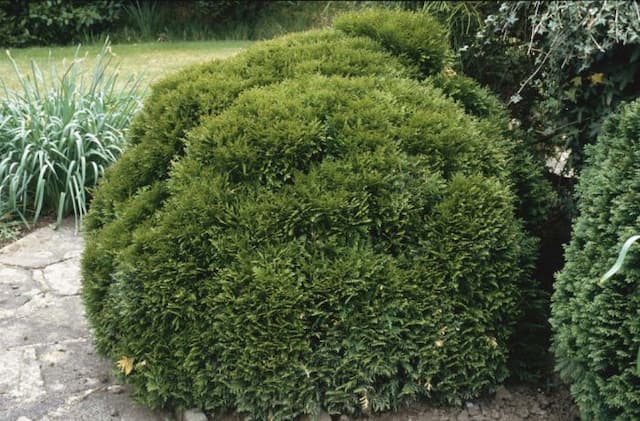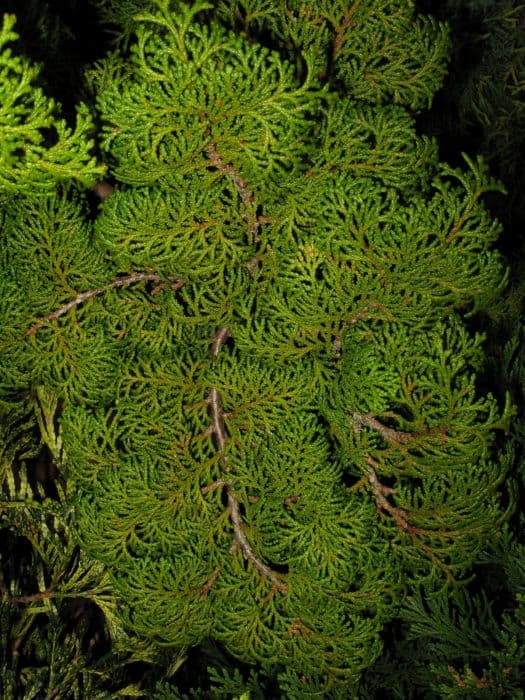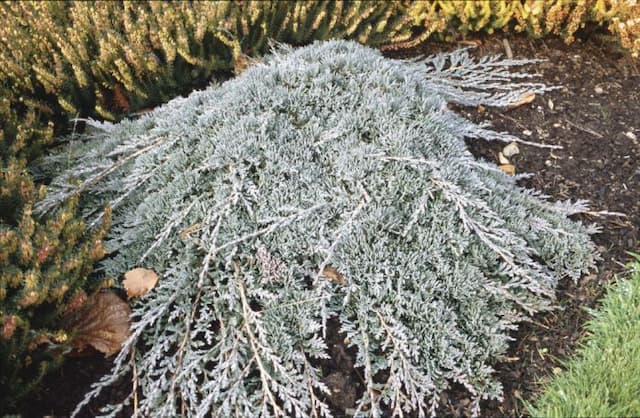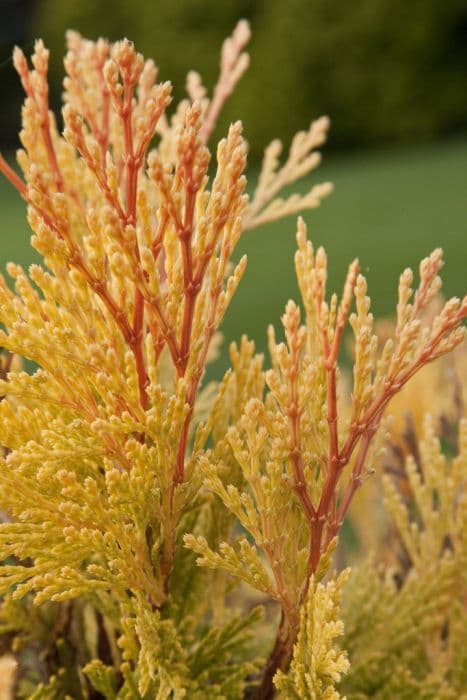Monterey Cypress Cupressus macrocarpa

ABOUT
The Monterey Cypress is an evergreen conifer that is widely recognized for its distinctive appearance. The foliage of this plant consists of scale-like leaves that are typically rich green in color, creating dense sprays that can have a slightly lemony scent when crushed. The leaves might also show a hint of blue or grayish-green, contributing to the plant's appealing texture and color. The Monterey Cypress is known for its irregular, sometimes contorted shape, which gives each tree a unique, picturesque silhouette. The branches of the Monterey Cypress tend to grow outwards and then curve upwards, giving the tree a somewhat flat-topped and spreading look. This sprawling growth habit adds to its windswept character, especially when found in coastal environments where it is often exposed to strong winds. When it comes to reproductive features, the Monterey Cypress has small cones, around 0.8 to 1.2 inches in diameter, that start off green and mature to a woody brown. These cones typically have a rough texture with six to ten scales that are tightly closed until they mature and open to release the seeds. The bark of the Monterey Cypress is also noteworthy, rough and fibrous, it usually displays a dark color which can range from gray to a reddish brown, often with deep furrows and ridges giving it a textured look. Overall, the Monterey Cypress has a rugged and enduring appearance, which is enhanced by its adaptability to coastal conditions, manifesting in its stout, wind-shaped form that stands as an emblem of resilience against the elements.
About this plant
 Names
NamesFamily
Cupressaceae
Synonyms
Monterey Cypress, Macrocarpa, Lambert Cypress
Common names
Cupressus macrocarpa Hartw., Cupressus hartwegii Carrière, Hesperocyparis macrocarpa (Hartw.) Bartel, Neocupressus macrocarpa (Hartw.) de Laub.
 Toxicity
ToxicityTo humans
The Monterey Cypress is not generally considered toxic to humans. There are no significant reports of poisoning or severe allergic reactions from the ingestion or handling of this plant. Therefore, accidental ingestion of parts of the Monterey Cypress is not likely to cause symptoms of poisoning in humans.
To pets
The Monterey Cypress is generally considered non-toxic to pets. It does not contain any known substances that are poisonous to cats, dogs, or other domestic animals. As with any non-food plant, ingestion of large quantities might cause mild gastrointestinal upset, but there are no specific toxic effects associated with this tree for pets.
 Characteristics
CharacteristicsLife cycle
Perennials
Foliage type
Evergreen
Color of leaves
Green
Height
40 feet (12 meters)
Spread
30 feet (9 meters)
Plant type
Tree
Hardiness zones
7
Native area
California
Benefits
 General Benefits
General Benefits- Landscape Aesthetics: Cupressus macrocarpa, commonly known as Monterey Cypress, is often used in landscaping for its attractive form and foliage, providing an aesthetic appeal to gardens and parks.
- Windbreaks and Privacy: The dense growth habit of the Monterey Cypress makes it an excellent choice for creating windbreaks and privacy screens.
- Erosion Control: The strong root system of the Monterey Cypress helps stabilize soil and prevent erosion on slopes and coastal regions.
- Habitat for Wildlife: Monterey Cypress trees provide shelter and habitat for various bird species and other wildlife.
- Wood Production: The wood of the Monterey Cypress is valued for its durability, workability, and resistance to decay, making it useful for construction, furniture, and landscaping projects.
- Ornamental Use: Monterey Cypress trees are popular for their ornamental values, particularly in bonsai culture, where their shape and texture are greatly appreciated.
- Shade and Cooling: The canopies of Monterey Cypress trees can offer shade, contributing to cooler environments in urban and suburban landscapes.
 Medical Properties
Medical Properties- This plant is not used for medical purposes.
 Air-purifying Qualities
Air-purifying QualitiesThis plant is not specifically known for air purifying qualities.
 Other Uses
Other Uses- Cupressus macrocarpa, commonly known as Monterey cypress, wood can be used for creating sculptures and artistic carvings due to its durability and attractive grain.
- The branches and foliage of the Monterey cypress can be processed into essential oils for use in aromatherapy, perfumes, and flavorings.
- This tree's durable, rot-resistant wood is used in boatbuilding, especially for small boats and decorative components.
- Monterey cypress is suitable for bonsai cultivation, offering a miniature landscape aesthetic for enthusiasts.
- The wood can be used for crafting musical instruments such as guitars and violins, enhancing acoustics with its resonant qualities.
- Wood from the Monterey cypress can be transformed into specialty papers and packaging, lending a unique texture and aroma to the products.
- Monterey cypress seed cones can be collected and used for educational purposes, such as teaching botany or conifer life cycles.
- Dried foliage is sometimes used for crafting garlands and wreaths for seasonal decorations due to its aromatic quality and evergreen appearance.
- Monterey cypress wood shavings and chips can be utilized as a natural mulch in gardening to suppress weeds and retain soil moisture.
- The tree's quick growth and shape make it popular in windbreaks and privacy screens in landscaping projects.
Interesting Facts
 Feng Shui
Feng ShuiThe Monterey Cypress is not used in Feng Shui practice.
 Zodiac Sign Compitability
Zodiac Sign CompitabilityThe Monterey Cypress is not used in astrology practice.
 Plant Symbolism
Plant Symbolism- Longevity and Immortality: Cupressus macrocarpa, commonly known as Monterey Cypress, often symbolizes immortality and eternal life due to its long-lasting nature and evergreen appearance.
- Endurance: As a species adapted to coastal environments with strong winds and salt spray, the Monterey Cypress represents endurance and the ability to withstand harsh conditions.
- Protection: With its dense foliage and tall stature, the Monterey Cypress is sometimes seen as a symbol of protection, providing shelter against the elements and creating a safe haven.
 Water
WaterThe Monterey Cypress should be watered deeply but infrequently to mimic its natural coastal environment. During the growing season, water the plant every 7 to 10 days with about 1 to 1.5 gallons per square yard, allowing the soil to dry out between waterings. In the winter, reduce watering to every 2 to 4 weeks depending on rainfall and temperature conditions. Adjust the amount of water and frequency to your local climate and the plant's specific location, ensuring that the soil at the root level is moist but not waterlogged.
 Light
LightThe Monterey Cypress requires full sun to grow well. It thrives best in a spot that receives at least 6 to 8 hours of direct sunlight per day. Avoid placing it in areas that are shaded for prolonged periods, as insufficient light can lead to sparse foliage and poor growth.
 Temperature
TemperatureThe Monterey Cypress prefers a temperate climate, typically thriving in temperatures between 40°F and 85°F. It can tolerate temperatures down to about 20°F, but it is not frost-hardy and should be protected from extreme cold. Ideal temperatures are within a range that is cool to moderate, without extended periods of heat exceeding 85°F.
 Pruning
PruningPrune the Monterey Cypress to shape it, control its size, and maintain its health by removing dead or diseased branches. The best time for pruning is in the late winter or early spring before new growth begins. Light pruning can be done at any time of year, but it's best to avoid heavy pruning outside the dormant season to prevent stress to the plant.
 Cleaning
CleaningAs needed
 Soil
SoilThe best soil mix for Monterey Cypress should be well-draining with sand or loam, slightly acidic to neutral pH, ideally between 6.3 and 7.5. Amending the soil with organic matter can help improve drainage and fertility.
 Repotting
RepottingMonterey Cypress doesn't often require repotting as it is typically grown as an outdoor tree; repot young trees every 2-3 years to encourage growth.
 Humidity & Misting
Humidity & MistingMonterey Cypress tolerates a wide range of humidity levels; coastal conditions are ideal, but it's adaptable to average outdoor humidity.
 Suitable locations
Suitable locationsIndoor
Ensure good light, avoid hot spots.
Outdoor
Full sun, shelter from strong winds.
Hardiness zone
7-10 USDA.
 Life cycle
Life cycleMonterey Cypress (Cupressus macrocarpa) begins its life cycle with germination from seed, which typically occurs within a suitable environment provided by well-drained sandy soils. The seedling emerges and grows into a juvenile tree, developing needle-like leaves and a conical shape characteristic of young cypresses. As it matures into an adult, the tree's growth rate slows, and it starts to produce cones—male cones release pollen, while female cones develop into seed-bearing structures after pollination. The mature Monterey Cypress can live for well over 100 years and reaches heights up to 70 feet or more. It can withstand harsh coastal winds and salt spray, which often leads to unique, sculpted growth forms. Eventually, after a long life, the tree dies, returning nutrients to the soil and providing habitat for various organisms, even in its decaying phase.
 Propogation
PropogationPropogation time
Late winter-early spring
Propogation: The Monterey Cypress, scientifically known as Cupressus macrocarpa, is typically propagated using seed or semi-hardwood cuttings. Propagation by seed occurs in late winter or early spring, ensuring that temperatures are cool enough to facilitate germination after stratification. The most popular method, however, is through cuttings, which are usually taken in late summer. To propagate by cuttings, one should select healthy semi-hardwood branches, cutting pieces around 6 inches long. The lower third of the cutting's foliage is removed, and the cut end is dipped into rooting hormone before being placed into a well-draining rooting medium. The cuttings are then kept moist and in a warm environment with indirect light until roots have developed, which can take several weeks. Once rooted, they can be potted individually and gradually acclimated to outdoor conditions before eventual planting.









